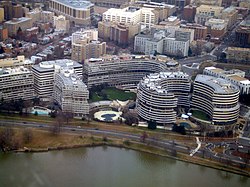
Back مجمع ووترغيت Arabic Watergate-Gebäudekomplex German Watergate French מתחם ווטרגייט HE Kompleks Watergate ID Watergate (Washington) Italian 워터게이트 콤플렉스 Korean Votergeito kompleksas Lithuanian Вотергејт Macedonian Kompleks Watergate Malay
Watergate | |
 Aerial view of the Watergate complex in 2006 | |
| Location | 2650 Virginia Ave. NW, Washington, D.C., U.S. |
|---|---|
| Coordinates | 38°53′56″N 77°03′15″W / 38.89889°N 77.05417°W |
| Area | Foggy Bottom |
| Built | 1963–1971 |
| Architect | Luigi Moretti, consulting architect; Milton Fischer, associate architect; Boris Timchenko, landscape architect |
| Architectural style | Modern Monument |
| NRHP reference No. | 05000540[1] |
| Added to NRHP | October 12, 2005 |

The Watergate complex is a group of six buildings in the Foggy Bottom neighborhood of Washington, D.C., United States. It is primarily a development of residences in cooperative ownership, but it also has a hotel and an office building (the location of the Watergate burglary, which led to the complex's infamy). Covering a total of 10 acres (4 ha) just north of the John F. Kennedy Center for the Performing Arts, the buildings include:
- Watergate West (2700 Virginia Avenue NW), cooperative apartments
- Watergate 600 (600 New Hampshire Avenue NW), office building
- Watergate Hotel (2650 Virginia Avenue NW)
- Watergate East (2500 Virginia Avenue NW), cooperative apartments[2]
- Watergate North (2510 Virginia Avenue NW), cooperative apartments (two lobbies, one is North and one is South)
- Watergate South (700 New Hampshire Avenue NW), cooperative apartments
- Watergate Office Building (2600 Virginia Ave NW), the office building where the Watergate burglary happened[3]
Built between 1963 and 1971, the Watergate became one of the most desirable living spaces in Washington, D.C., popular with members of Congress and political appointees of the executive branch.[2][4] The complex has been sold several times since the 1980s. During the 1990s, it was subdivided and its component buildings and parts of buildings were sold to various owners.[5][6]
In 1972, the headquarters of the Democratic National Committee, then located on the sixth floor of the Watergate Office Building, was burgled; private campaign documents were photographed and telephones were wiretapped.[7] The U.S. Senate investigation into the burglary revealed that high officials in the administration of President Richard Nixon had ordered the break-in and later tried to cover up their involvement. Additional crimes were also uncovered. The Watergate scandal, named after the complex, resulted in Nixon's resignation on August 9, 1974.[8][9][10][11]
The name "Watergate" and the suffix "-gate" have since become synonymous with and applied by journalists to controversial topics and scandals in the United States and elsewhere, even extending to contexts where English is not a major language.[12][13][14][15][16]
- ^ "National Register Information System". National Register of Historic Places. National Park Service. March 15, 2006.
- ^ a b Cite error: The named reference
MacPhersonStatuswas invoked but never defined (see the help page). - ^ Hedgpeth, Dana (May 21, 2005). "Watergate Offices on the Market". The Washington Post.
- ^ Cite error: The named reference
Livingstonwas invoked but never defined (see the help page). - ^ Cite error: The named reference
Haggertywas invoked but never defined (see the help page). - ^ Cite error: The named reference
Salewas invoked but never defined (see the help page). - ^ Cite error: The named reference
LewisPlotwas invoked but never defined (see the help page). - ^ Kilpatrick, Carroll (August 9, 1974). "Nixon Resigns". The Washington Post. Archived from the original on December 19, 2016.
- ^ Woodward, Bob; Bernstein, Carl (2005). The Final Days. New York: Simon and Schuster. ISBN 0-7432-7406-7.
- ^ Genovese, Michael (1999). The Watergate Crisis. Santa Barbara, California: Greenwood Publishing Group. ISBN 0-313-29878-5.
- ^ Kutler, Stanley I. (1992). The Wars of Watergate: The Last Crisis of Richard Nixon (Reprint ed.). New York: W. W. Norton & Company. ISBN 0-393-30827-8.
- ^ Cite error: The named reference
Trahair1994was invoked but never defined (see the help page). - ^ Cite error: The named reference
SmithRichter1993was invoked but never defined (see the help page). - ^ Cite error: The named reference
LullHinerman1997was invoked but never defined (see the help page). - ^ Cite error: The named reference
Hamilton1992was invoked but never defined (see the help page). - ^ Cite error: The named reference
Marirrodriga2008was invoked but never defined (see the help page).
